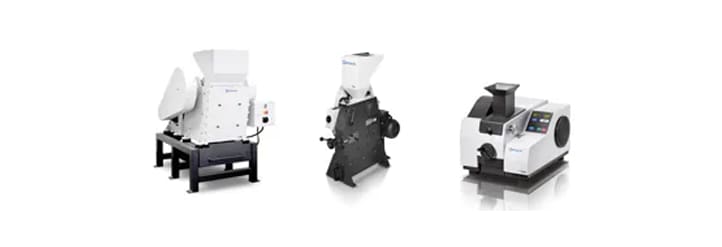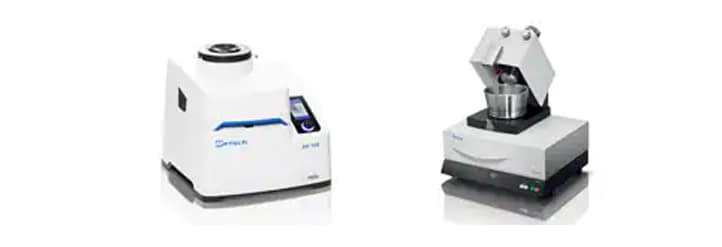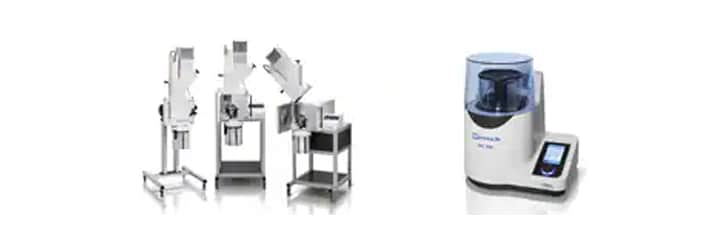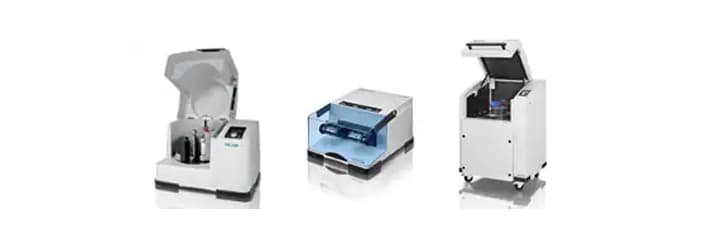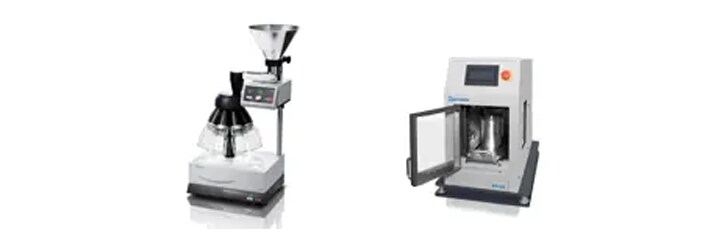UserName
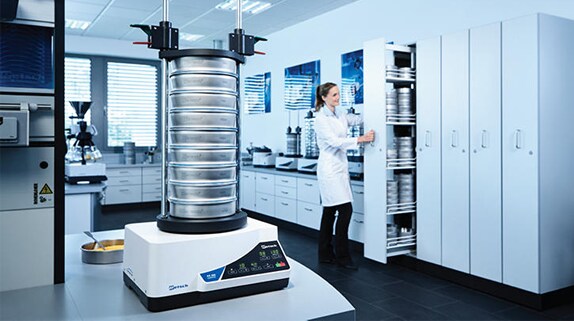
Retsch
RETSCH’s philosophy is based on customer orientation and leading edge technology. This is reflected in instruments whose high-quality components are designed for perfect interaction. RETSCH products not only guarantee representative and reproducible results for grinding and particle analysis but also allow for easy and comfortable operation.
- About
- Products
- Applications
- Special Offers
- Resources
Top Categories
Featured Products
Catalog Number 17629295
Retsch Ultra Centrifugal Mill ZM 300
Catalog Number 10573034
RETSCH MM 400 Mixer Mill
Catalog Number 15582515
RETSCH Sieve Shaker AS 200 control
Catalog Number 15702799
Retsch™ Knife Mill GRINDOMIX GM 200
Related Resources

- 2x
- 1.75x
- 1.5x
- 1.25x
- 1x, selected
- 0.75x
- 0.5x
- Chapters
- descriptions off, selected
- captions settings, opens captions settings dialog
- captions off, selected
- en (Main), selected
This is a modal window.
Beginning of dialog window. Escape will cancel and close the window.
End of dialog window.
This is a modal window. This modal can be closed by pressing the Escape key or activating the close button.
RETSCH Company Video
RETSCH is the leading solution provider for neutral-to-analysis sample preparation and characterization of solids. Based on a century of experience RETSCH develops size reduction and sieving equipment.

- 2x
- 1.75x
- 1.5x
- 1.25x
- 1x, selected
- 0.75x
- 0.5x
- Chapters
- descriptions off, selected
- captions settings, opens captions settings dialog
- captions off, selected
- en (Main), selected
This is a modal window.
Beginning of dialog window. Escape will cancel and close the window.
End of dialog window.
This is a modal window. This modal can be closed by pressing the Escape key or activating the close button.
Ultra Centrifugal Mill ZM 300
Provides maximum grinding performance combined with ease of use. Variable speed from 6000 to 23,000 rpm allows for gentle, neutral-to-analysis sample preparation in a very short time.

- 2x
- 1.75x
- 1.5x
- 1.25x
- 1x, selected
- 0.75x
- 0.5x
- Chapters
- descriptions off, selected
- captions settings, opens captions settings dialog
- captions off, selected
This is a modal window.
Beginning of dialog window. Escape will cancel and close the window.
End of dialog window.
This is a modal window. This modal can be closed by pressing the Escape key or activating the close button.
Mixer Mill MM 500 Vario
Versatile bench-top unit which provides ultimate performance with maximum flexibility for your sample preparation process. Used for dry, wet and cryogenic grinding of small sample amounts with high throughput.

About Retsch
RETSCH’s philosophy is based on customer orientation and leading edge technology. This is reflected in instruments whose high-quality components are designed for perfect interaction. RETSCH products not only guarantee representative and reproducible results for grinding and particle analysis but also allow for easy and comfortable operation.
All Products
RETSCH Couteau de rechange en acier inoxydable
Tourne au centre du récipient de broyage Grindomixer GM 200. Le couteau de rechange en acier inoxydable Retsch™ permet la fragmentation et le broyage fin selon le sens de rotation. Le couteau est indirectement entraîné par un puissant moteur de 900 W.

Toute commande passée avant 14h sera expédiée dès aujourd'hui
Toute commande passée après 14h sera expédiée dès demain
En savoir plus
RETSCH Récipients de broyage pour broyeur à couteaux GRINDOMIX GM 200
À utiliser avec les broyeurs à couteaux GRINDOMIX GM 200.

Toute commande passée avant 14h sera expédiée dès aujourd'hui
Toute commande passée après 14h sera expédiée dès demain
En savoir plus
RETSCH Accessoires pour le broyeur à couteaux Grindomix GM200
Accessoires à utiliser avec le broyeur à couteaux Grindomix GM200

Toute commande passée avant 14h sera expédiée dès aujourd'hui
Toute commande passée après 14h sera expédiée dès demain
En savoir plus
RETSCH Microbilles de verre pour laminoirs
Pour utilisation avec le Mixer Mill MM 200 Retsch.

Toute commande passée avant 14h sera expédiée dès aujourd'hui
Toute commande passée après 14h sera expédiée dès demain
En savoir plus
| Type | Billes |
|---|---|
| À utiliser avec (équipement) | Broyeur mélangeur MM 200 |
| Matériau | Verre |
| Quantité | 500 g |
Retsch™ Tamis de test avec mailles de dimension 1,00 à 10,00 mm
Les tamis de test Retsch™ se composent d’un cadre solide en acier inox avec une stabilité élevée, ce qui donne des résultats de tamisage fiables.

Toute commande passée avant 14h sera expédiée dès aujourd'hui
Toute commande passée après 14h sera expédiée dès demain
En savoir plus
| Certifications/Conformité | DIN ISO 3310-1 |
|---|---|
| Hauteur (métrique) | 50 mm |
| Matériau | Acier inoxydable |
| Diamètre (métrique) externe | 200 mm |
| Comprend | Certificat d’étalonnage |
RETSCH Cuvettes en aluminium pour presse à pelletisation PP25

Toute commande passée avant 14h sera expédiée dès aujourd'hui
Toute commande passée après 14h sera expédiée dès demain
En savoir plus
| Type | Coupelle en aluminium |
|---|---|
| À utiliser avec (équipement) | Presse à pelletisation PP 25 |
| Matériau | Aluminium |
RETSCH Broyeurs mélangeurs MM 400 : Bols de broyage
Pour une utilisation avec les broyeurs mélangeurs MM 400

Toute commande passée avant 14h sera expédiée dès aujourd'hui
Toute commande passée après 14h sera expédiée dès demain
En savoir plus
| À utiliser avec (équipement) | Broyeur-mélangeur MM 400 |
|---|---|
| Type de produit | Bol de broyage |
| Type de bouchon | Bouchon vissé |
| À utiliser avec (application) | Idéal pour un broyage étanche |
Fisherbrand™ Tamis de test en acier inoxydable, 200 x 25 mm (Ø x H), ISO 3310/1
Utilisés pour la séparation, le fractionnement ou la détermination de la granulométrie. Ces tamis de test en acier inox ont une hauteur interne de 25 mm et un diamètre de 200 mm. Disponibles dans une large gamme de porosités entre 1 mm et 10 mm.

Toute commande passée avant 14h sera expédiée dès aujourd'hui
Toute commande passée après 14h sera expédiée dès demain
En savoir plus
| Type | Tamis |
|---|---|
| Hauteur (métrique) | 25 mm |
| À utiliser avec (équipement) | Agitateur AS 200 |
| Diamètre (métrique) externe | 200mm |
| Mesh Material | Acier inoxydable |
| Matériau de la monture | Acier inoxydable |
| Quantité | 1 unité |
| À utiliser avec (application) | Pour la séparation, le fractionnement et la détermination de la granulométrie |
RETSCH Tamis de test en acier inox 203,2 x 50,8 mm (dia. x H), certificat ISO, porosités en micromètres

Toute commande passée avant 14h sera expédiée dès aujourd'hui
Toute commande passée après 14h sera expédiée dès demain
En savoir plus
| Certifications/Conformité | ISO 3310/1 |
|---|---|
| Type | Tamis |
| Hauteur (métrique) | 50,8mm |
| À utiliser avec (équipement) | Agitateur AS 300 |
| Matériau | Acier inoxydable |
| Diamètre (métrique) externe | 203,2mm |
| Mesh Material | Acier inoxydable |
| Matériau de la monture | Acier inoxydable |
| Quantité | 1Each |
| À utiliser avec (application) | Pour la séparation, le fractionnement et la détermination de la granulométrie |
RETSCH Billes de broyage pour broyeur planétaire à billes PM 100
À utiliser avec les broyeurs planétaires à billes PM 100 et PM 200 Retsch

Toute commande passée avant 14h sera expédiée dès aujourd'hui
Toute commande passée après 14h sera expédiée dès demain
En savoir plus
| À utiliser avec (équipement) | Broyeur à billes planétaire PM 100 et PM 200 |
|---|---|
| Type de produit | Boulet de broyage |
RETSCH Sac filtrant en nylon

Toute commande passée avant 14h sera expédiée dès aujourd'hui
Toute commande passée après 14h sera expédiée dès demain
En savoir plus
RETSCH Cônes inférieurs

Toute commande passée avant 14h sera expédiée dès aujourd'hui
Toute commande passée après 14h sera expédiée dès demain
En savoir plus
| Type de produit | Cône de fond |
|---|
Retsch™ Tamis de test avec micromailles
Les tamis de test Retsch™ se composent d’un cadre solide en acier inox avec une stabilité élevée, ce qui donne des résultats de tamisage fiables.

Toute commande passée avant 14h sera expédiée dès aujourd'hui
Toute commande passée après 14h sera expédiée dès demain
En savoir plus
| Certifications/Conformité | DIN ISO 3310-1 |
|---|---|
| Hauteur (métrique) | 50 mm |
| Matériau | Acier inoxydable |
| Diamètre (métrique) externe | 200 mm |
| Comprend | Certificat d’étalonnage |
RETSCH Billes de broyage en acier inoxydable
Conçues pour une utilisation avec les broyeurs mélangeurs Retsch™. Les billes de broyage en acier inox Retsch™ sont idéales pour le broyage de cellules biologiques et pour l’extraction d’ADN / ARN.
| Matériau | Acier inoxydable |
|---|---|
| Type de produit | Boulets de broyage |
| Certifications/Conformité | ISO 3310/2 |
|---|---|
| Type | Tamis |
| Hauteur (métrique) | 50mm |
| Diamètre (métrique) externe | 200mm |
| Mesh Material | Acier inoxydable |
| Matériau de la monture | Acier inoxydable |
| Quantité | 1 unité |
| Comprend | Certificat de conformité |
| À utiliser avec (application) | Pour la séparation, le fractionnement et la détermination de la granulométrie |
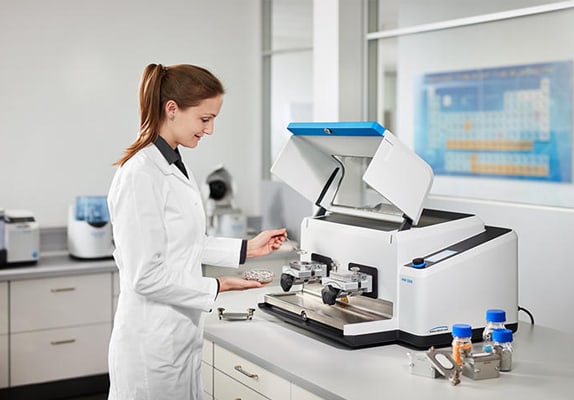
Laboratory Mills, Grinders and Crushers
For chemical and physical analytical methods such as AAS, NIR, ICP or XRF it is essential that the specimen is perfectly homogenized to an adequate degree of analytical fineness. A reliable and accurate analysis can only be guaranteed by reproducible sample preparation.
For these tasks RETSCH offers a comprehensive range of the most modern mills and crushers for coarse, fine and ultrafine size reduction of almost any material. The choice of grinding tools and accessories ensures that our instruments provide for contamination-free and reliable sample preparation prior to laboratory analysis.

Sieving
Particle size analysis according to DIN EN ISO 9000 ff. Particle size distribution influences the physical and chemical properties of solids. Therefore this criterion is of highest importance in the context of science and quality control.
Only if the size distribution remains constant, a steady product quality can be guaranteed, as the following examples show:
- the strength of concrete depends on the particle size of the cement
- the taste of chocolate is influenced by the fineness of the cocoa
- the flow characteristics and solubility of washing powders depend on the fineness and particle shape of the basic materials
RETSCH sieve shakers, test sieves and evaluation software provide the key to easy, rapid, reproducible and, above all, accurate analyses.
Special Offers

Sorry, there are currently no special offers at this time.
Resources
General Catalogue
RETSCH’s philosophy is based on customer orientation and leading edge technology.
- Filename
- 17557_brochure_catalogue_general_en.pdf
- Size
- 13 MB
- Format
- application/pdf
Product Overview
First class product quality thanks to advanced manufacturing methods, this is reflected in instruments whose high-quality components are designed for perfect interaction.
- Filename
- 17557_brochure_overview_en.pdf
- Size
- 3 MB
- Format
- application/pdf
The Art of Milling
An expert guide to neutral-to-analysis size reductionand homogenization in the laboratory.
- Filename
- 17557_expert_guide_milling_en.pdf
- Size
- 1 MB
- Format
- application/pdf
Sieve Analysis
Taking a close look at quality: an expert guide to particle size analysis.
- Filename
- 17557_expert_guide_sieving_en.pdf
- Size
- 2 MB
- Format
- application/pdf
White Paper - Different Sieving Methods for a Variety of Applications
The determination and knowledge of the particle size distribution is an essential part of the quality control process for industrial products. Easy handling, low investment cost and high accuracy make sieve analysis one of the most frequently used procedures for measuring the particle size. This white paper gives an overview of the different sieving techniques and describes the necessary steps to ensure reliable results.
- Filename
- 17557_more_resources_1.pdf
- Size
- 716 KB
- Format
- application/pdf
White Paper - Cryogenic Preparation of Sample Materials
A solid sample material should always be sufficiently prepared by size reduction and homogenization before it is subjected to chemical or physical analysis. Care should be taken that the analysis sample fully represents the original material and that the sample preparation process is carried out reproducibly. Most sample materials can be reduced to the required analytical fineness at room temperature by choosing a mill with a suitable size reduction principle (impact, pressure, friction, shearing, cutting).
- Filename
- 17557_more_resources_2.pdf
- Size
- 525 KB
- Format
- application/pdf
White Paper - How to Minimize Standard Deviations by Correct Sample Preparation
Modern analytical methods increase precision and push detection limits to make even the smallest traces of sample components detectable. Despite this development sample preparation, which is carried out prior to the actual analysis, is frequently neglected. Errors caused by lacking accuracy in sample preparation have a much bigger impact than errors made during analysis.
- Filename
- 17557_more_resources_3.pdf
- Size
- 1020 KB
- Format
- application/pdf
White Paper - Important Aspects of Sample Preparation of Biological Materials
Biological samples exist in all shapes and sizes: hard bones, tough and fibrous plants, tough and viscous sputum, soft muscles, tumor or liver tissue. Not to mention the millions of cells such as yeast, bacteria or algae, which have to be disrupted for applications such as DNA or RNA isolation or protein extraction. Retsch offers a range of mills and grinders for easy and reproducible pulverization of solid sample materials some of which are also suitable for cell disruption and homogenization of biological sample materials.
- Filename
- 17557_more_resources_4.pdf
- Size
- 1 MB
- Format
- application/pdf
White Paper - Reproducible Sample Preparation for Reliable Food Analysis
Food occurs in a great variety of consistencies and is often inhomogeneous. Food testing labs require representative samples to produce meaningful and reproducible analysis results. Therefore, food samples must be homogenized and pulverized to the required analytical fineness, ideally with as little time and effort as possible.
- Filename
- 17557_more_resources_5.pdf
- Size
- 878 KB
- Format
- application/pdf
White Paper - Ultrafine Grinding with Laboratory Ball Mills
How are nano particles produced? The “Bottom-Up” method synthesizes particles from atoms or molecules. The “Top-Down” method involves reducing the size of larger particles to nanoscale, for example with laboratory mills. Nano particles are produced by colloidal grinding which involves dispersion of the particles in liquid to neutralize the surface charges. Factors such as energy input and size reduction principle make ball mills the best choice for the production of nanoparticles.
- Filename
- 17557_more_resources_6.pdf
- Size
- 994 KB
- Format
- application/pdf
50 YEARS of Defining Standards in Quality Control - New Ultra Centrifugal Mill ZM 300
Nothing matches the performance of the original! RETSCH's Ultra Centrifugal Mills set standards in sample homogenization with more than 20,000 installations world-wide. The outstanding performance, flexibility, user-friendliness and robustness of this highspeed rotor mill make it the undisputed leader in its class.
- Filename
- 17557_more_resources_7.pdf
- Size
- 411 KB
- Format
- application/pdf



